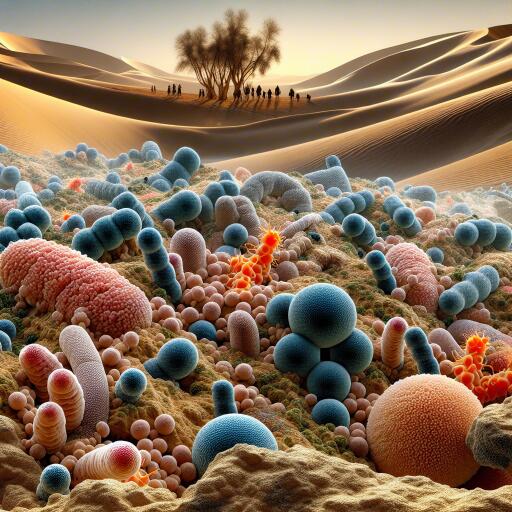
Desert Soil Microbes: Masters of Extreme Dryland Survival
Spanning a massive 46% of the earth’s terrestrial expanse, drylands are unique ecosystems pivotal to our planet, yet they are under increasing threat from the dual challenges of climate change and unsustainable land practices. Beneath the sparse blanket of vegetation, a concealed realm thrives, inhabited by microorganisms embedded within the desert’s biological crust or ‘biocrust.’ These microscopic inhabitants play a vital role in enhancing soil fertility, introducing critical nutrients like carbon and nitrogen, bolstering against erosion, and improving water retention.
For years, the resilience strategies that empower these microorganisms to flourish under the extremities of dry conditions punctuated by infrequent rainfall episodes remained a mystery. Recent advancements in microbial research have peeled back the layers of this enigma, shedding light on the remarkable survival tactics of desert soil bacteria.
Findings from recent research narrate an intriguing tale of survival, revealing that desert soil bacteria spend most of their time in a state of dormancy. This dormant state is a survival mechanism, a pause button of sorts, allowing them to withstand prolonged periods of aridity. However, the moment rainwater touches the dry soil, it sparks a remarkable transformation. Within minutes, an impressive span of microbial diversity shifts from dormancy into a burst of activity. This swift transition is emblematic of an ‘all-in’ strategy towards reactivation, crucial for both energy generation and DNA repair, ensuring their survival in the fleeting wet conditions.
The study introduces a groundbreaking approach involving NanoSIMS technology and the utilization of stable isotope-labeled water, offering a doorway to observe how these bacteria integrate heavy hydrogen atoms during mimic rain events. This sophisticated technique unveiled that although the majority of biocrust cells awaken with the touch of rain, only a selective few are able to proliferate due to the transient nature of desert rainfall. This discovery not only underscores the adaptability of soil microbiota to sudden moisture influx but also highlights a critical growth limitation imposed by the brevity of desert rains.
This exploration into the survival mechanisms of desert soil microbes unveils their unparalleled adaptability to extreme variations in soil moisture—a trait imperative for enduring the harsh desert climate. Furthermore, the resilience and adaptive strategies of these microorganisms carry broader implications. As global climates skew towards increasing dryness, understanding these microbial behaviors offers valuable insights into adaptation strategies across ecosystems facing the threat of drought.
The resilience of desert soil bacteria underscores a fascinating aspect of biocrust’s role in desert ecosystems, providing essential ecological services from nutrient cycling to erosion prevention. Their ability to swiftly transition from a dormant state to active growth during rare rainfall episodes showcases an evolutionary adaptation that could offer lessons in surviving in increasingly arid climates. As drylands continue to expand and the frequency of droughts increases worldwide, the study of these microorganisms could become crucial in developing strategies to mitigate the impacts of climate change and support sustainable land management in vulnerable ecosystems.
In conclusion, the research into the microscopic life thriving in the parched soils of the world’s drylands reveals a tapestry of life adapted to extremes. The resilience of desert soil microbes not only highlights their crucial role in sustaining the fragile ecosystems of drylands but also serves as a testament to the adaptability of life under the most challenging conditions. As we navigate the complexities of climate change, these microorganisms offer profound lessons in endurance, resilience, and the delicate balance of terrestrial ecosystems.





Leave a Reply